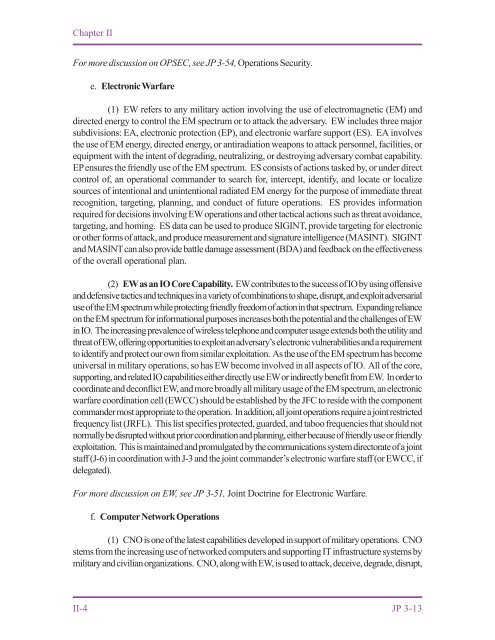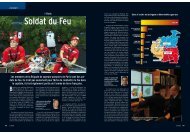Joint Publication 3-13, Information Operations - The Global ...
Joint Publication 3-13, Information Operations - The Global ...
Joint Publication 3-13, Information Operations - The Global ...
You also want an ePaper? Increase the reach of your titles
YUMPU automatically turns print PDFs into web optimized ePapers that Google loves.
Chapter II<br />
For more discussion on OPSEC, see JP 3-54, <strong>Operations</strong> Security.<br />
e. Electronic Warfare<br />
(1) EW refers to any military action involving the use of electromagnetic (EM) and<br />
directed energy to control the EM spectrum or to attack the adversary. EW includes three major<br />
subdivisions: EA, electronic protection (EP), and electronic warfare support (ES). EA involves<br />
the use of EM energy, directed energy, or antiradiation weapons to attack personnel, facilities, or<br />
equipment with the intent of degrading, neutralizing, or destroying adversary combat capability.<br />
EP ensures the friendly use of the EM spectrum. ES consists of actions tasked by, or under direct<br />
control of, an operational commander to search for, intercept, identify, and locate or localize<br />
sources of intentional and unintentional radiated EM energy for the purpose of immediate threat<br />
recognition, targeting, planning, and conduct of future operations. ES provides information<br />
required for decisions involving EW operations and other tactical actions such as threat avoidance,<br />
targeting, and homing. ES data can be used to produce SIGINT, provide targeting for electronic<br />
or other forms of attack, and produce measurement and signature intelligence (MASINT). SIGINT<br />
and MASINT can also provide battle damage assessment (BDA) and feedback on the effectiveness<br />
of the overall operational plan.<br />
(2) EW as an IO Core Capability. EW contributes to the success of IO by using offensive<br />
and defensive tactics and techniques in a variety of combinations to shape, disrupt, and exploit adversarial<br />
use of the EM spectrum while protecting friendly freedom of action in that spectrum. Expanding reliance<br />
on the EM spectrum for informational purposes increases both the potential and the challenges of EW<br />
in IO. <strong>The</strong> increasing prevalence of wireless telephone and computer usage extends both the utility and<br />
threat of EW, offering opportunities to exploit an adversary’s electronic vulnerabilities and a requirement<br />
to identify and protect our own from similar exploitation. As the use of the EM spectrum has become<br />
universal in military operations, so has EW become involved in all aspects of IO. All of the core,<br />
supporting, and related IO capabilities either directly use EW or indirectly benefit from EW. In order to<br />
coordinate and deconflict EW, and more broadly all military usage of the EM spectrum, an electronic<br />
warfare coordination cell (EWCC) should be established by the JFC to reside with the component<br />
commander most appropriate to the operation. In addition, all joint operations require a joint restricted<br />
frequency list (JRFL). This list specifies protected, guarded, and taboo frequencies that should not<br />
normally be disrupted without prior coordination and planning, either because of friendly use or friendly<br />
exploitation. This is maintained and promulgated by the communications system directorate of a joint<br />
staff (J-6) in coordination with J-3 and the joint commander’s electronic warfare staff (or EWCC, if<br />
delegated).<br />
For more discussion on EW, see JP 3-51, <strong>Joint</strong> Doctrine for Electronic Warfare.<br />
f. Computer Network <strong>Operations</strong><br />
(1) CNO is one of the latest capabilities developed in support of military operations. CNO<br />
stems from the increasing use of networked computers and supporting IT infrastructure systems by<br />
military and civilian organizations. CNO, along with EW, is used to attack, deceive, degrade, disrupt,<br />
II-4<br />
JP 3-<strong>13</strong>



